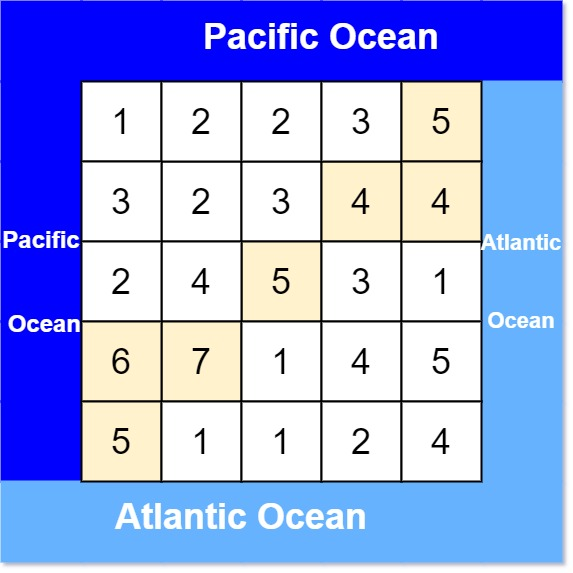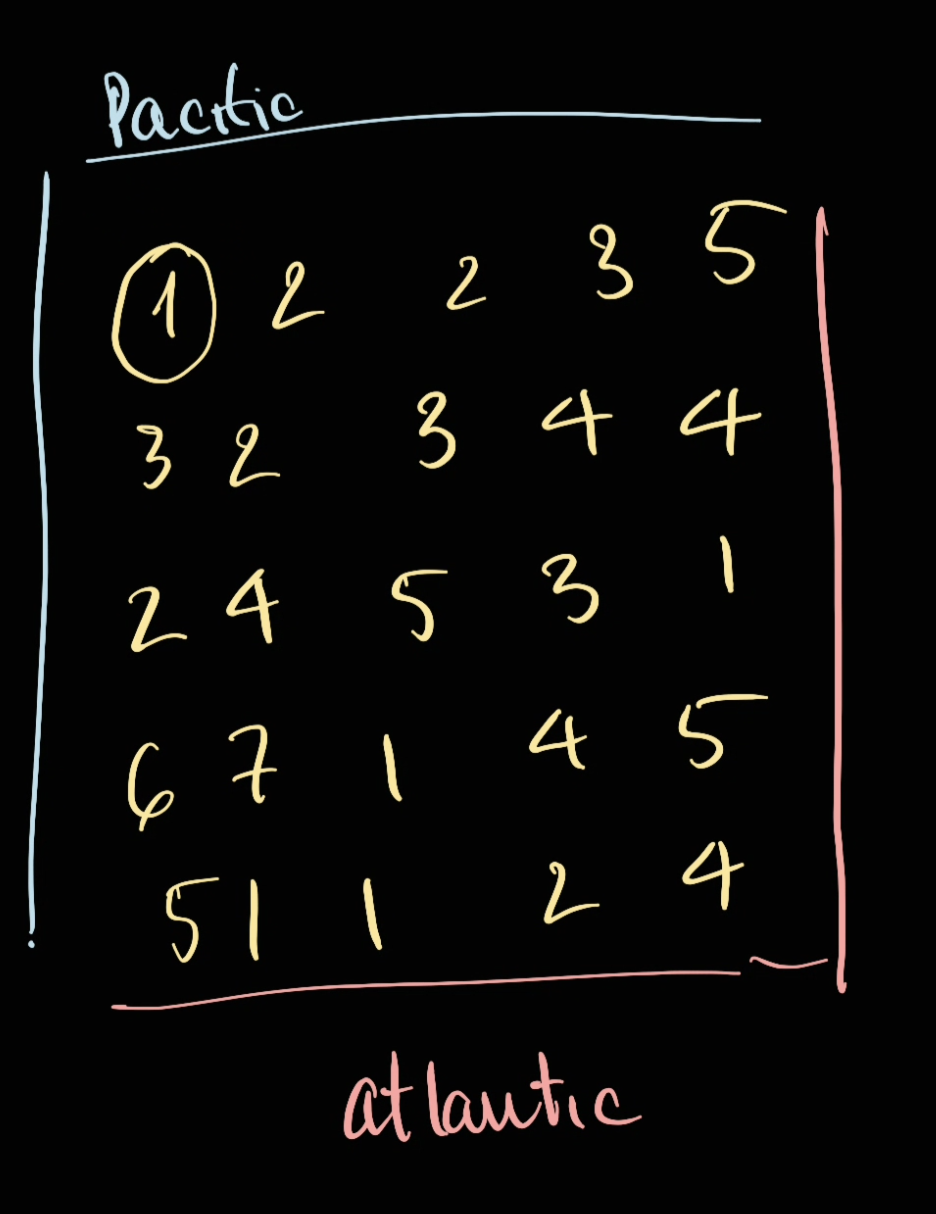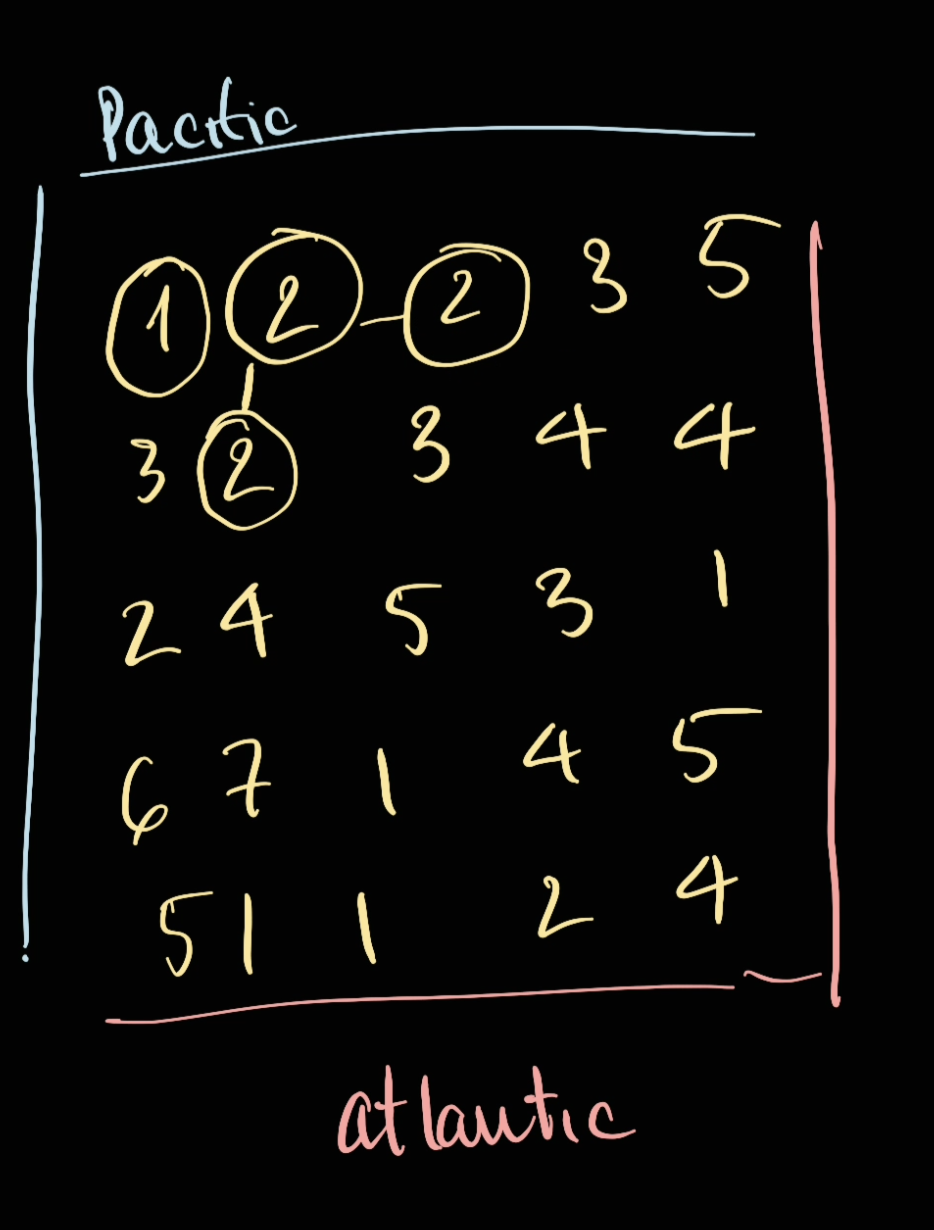Pacific Atlantic Water Flow
Question
There is an m x n rectangular island that borders both the Pacific Ocean and Atlantic Ocean. The Pacific Ocean touches the island's left and top edges, and the Atlantic Ocean touches the island's right and bottom edges.
The island is partitioned into a grid of square cells. You are given an m x n integer matrix heights where heights[r][c] represents the height above sea level of the cell at coordinate (r, c).
The island receives a lot of rain, and the rain water can flow to neighboring cells directly north, south, east, and west if the neighboring cell's height is less than or equal to the current cell's height. Water can flow from any cell adjacent to an ocean into the ocean.
Return a 2D list of grid coordinates result where result[i] = [ri, ci] denotes that rain water can flow from cell (ri, ci) to both the Pacific and Atlantic oceans.
Example 1:

Input: heights = [[1,2,2,3,5],[3,2,3,4,4],[2,4,5,3,1],[6,7,1,4,5],[5,1,1,2,4]]
Output: [[0,4],[1,3],[1,4],[2,2],[3,0],[3,1],[4,0]]
Explanation: The following cells can flow to the Pacific and Atlantic oceans, as shown below:
[0,4]: [0,4] -> Pacific Ocean
[0,4] -> Atlantic Ocean
[1,3]: [1,3] -> [0,3] -> Pacific Ocean
[1,3] -> [1,4] -> Atlantic Ocean
[1,4]: [1,4] -> [1,3] -> [0,3] -> Pacific Ocean
[1,4] -> Atlantic Ocean
[2,2]: [2,2] -> [1,2] -> [0,2] -> Pacific Ocean
[2,2] -> [2,3] -> [2,4] -> Atlantic Ocean
[3,0]: [3,0] -> Pacific Ocean
[3,0] -> [4,0] -> Atlantic Ocean
[3,1]: [3,1] -> [3,0] -> Pacific Ocean
[3,1] -> [4,1] -> Atlantic Ocean
[4,0]: [4,0] -> Pacific Ocean
[4,0] -> Atlantic Ocean
Note that there are other possible paths for these cells to flow to the Pacific and Atlantic oceans.
Example 2
Input: heights = [[1]]
Output: [[0,0]]
Explanation: The water can flow from the only cell to the Pacific and Atlantic oceans.
Solution
Brute force solution
One of the obvious way is to bruteforce through our answer. In here, it's intuitive to think of a solution to traverse from a cell to see if it reaches the ocean or not.
For example, given the example above, we can try to start with node 1 and see how far we can go:

In here we can see that 1 cannot go anywhere, therefore, we're going to node 2:

As you can see, from 2 we can expand out but not much, as a result we can only reach to Pacific but not Atlantic.
We will repeat this process for every node inside the ocean.
Implementation
We can do a DFS for each cell in the ocean. Note that for each DFS traversal we have:
visitedset:- For the DFS function to work, because it needs to travel from one node to another node without overlapping the path
oceansetWe need to keep track of successful records into this ocean set in order to find which node in both
oceanset later.However this needs to be distinct from the
visitedset because a node insidevisitedset might not be insideoceanset.Therefore we cannot use the
oceanset itself as BFS traversal visited set as is not large enough to cover all our search space.
[!note]
In here we chose DFS because if we choose BFS, we need to pop out the cells from the ocean. And because of that, we would not have the cell in each ocean to perform a compare
class App:
def __init__(self) -> None:
self.ATLANTIC = 1
self.PACIFIC = 0
pass
def pacificAtlantic(self, heights: List[List[int]]) -> List[List[int]]:
if not heights or len(heights) == 0:
raise Exception("Illegal Arugment")
result = []
canFlowAtlantic = set()
canFlowPacific = set()
for row in range(len(heights)):
for col in range(len(heights[0])):
if self.canReachOcean(heights, row, col, canFlowAtlantic, oceanType = self.ATLANTIC, visited=set()):
canFlowAtlantic.add((row, col))
if self.canReachOcean(heights, row, col, canFlowPacific, oceanType = self.PACIFIC, visited=set()):
canFlowPacific.add((row, col))
if ((row, col) in canFlowPacific and (row, col) in canFlowAtlantic):
result.append([row, col])
return result
def hasReachedOcean(self, heights, oceanType, row, col):
if oceanType == self.ATLANTIC:
return row == len(heights) - 1 or col == len(heights[0]) - 1
if oceanType == self.PACIFIC:
return row == 0 or col == 0
raise Exception("Invalid oceantype", oceanType)
def isInvalid(self, heights, row, col):
return row < 0 or col < 0 or row >= len(heights) or col >= len(heights[0])
def canReachOcean(self, heights, row, col, canFlowToOcean: Set[Tuple[int, int]], oceanType, visited: Set[Tuple[int, int]]) -> bool:
if (row, col) in visited: return False
if (row, col) in canFlowToOcean: return True
visited.add((row, col))
if self.hasReachedOcean(heights, oceanType, row, col):
return True
for dr, dc in [(1,0), (-1, 0), (0, 1), (0, -1)]:
nextRow, nextCol = row + dr, col + dc
if not self.isInvalid(heights, nextRow, nextCol) and heights[nextRow][nextCol] <= heights[row][col]:
if (self.canReachOcean(heights, nextRow, nextCol, canFlowToOcean, oceanType, visited=visited)):
canFlowToOcean.add((nextRow, nextCol))
return True
return False
For each cells, we do a DFS to check if the cell can reach to the ocean or not. If it can we will put that into the corresponding ocean set.
Time complexity:
- For each row, column we need to traverse because of the DFS
- We need to repeat the above step for every row, columnar
Space complexity:
- We have an array of as given. For each cell:
- We have a
visitedset of pairs of(row, col)for each DFS - We also have 2
visitedset for each ocean
- We have a
- We also have additional 2
oceanset outside of pair(row, col) - Lastly we have a result set of
(row, col)
Optimised solution
If you think about this problem, it's better to to traverse backward from the solution. Because ideally we want to find the cells that can reach to the ocean, so can search from the ocean to see which are the cells that can reach the ocean
In here since we're traversing from the answer space, we only need:
oceanset:- This could be using as a
visitedset as well as theoceanset. - Since we're traversing from the answer space, we only add candidates that is reachable to the solution in our search space. Therefore our
- This could be using as a
Implementation
class App:
graph: List[List[int]]
def pacificAtlantic(self, heights: List[List[int]]) -> List[List[int]]:
if not heights or len(heights) == 0:
raise Exception("Illegal Arugment")
self.graph = heights
pacificReachable: Set[Tuple[int, int]] = set()
atlanticReachable: Set[Tuple[int, int]] = set()
# Explore out from Pacific
for c in range(len(self.graph[0])):
self.dfsExplore(0, c, pacificReachable)
for r in range(len(self.graph)):
self.dfsExplore(r, 0, pacificReachable)
# Explore out from Atlantic
for c in range(len(self.graph[0])):
self.dfsExplore(len(self.graph) - 1, c, atlanticReachable)
for r in range(len(self.graph)):
self.dfsExplore(r, len(self.graph[0]) - 1, atlanticReachable)
result = []
# Collect the tiles that reaches both pacific and atlantic
for row in range(len(self.graph)):
for col in range(len(self.graph[0])):
tile = (row, col)
if tile in pacificReachable and tile in atlanticReachable:
result.append([row, col])
return result
def dfsExplore(self, row, col, reachableOcean: Set[Tuple[int, int]]):
if (row, col) in reachableOcean: return
reachableOcean.add((row, col))
for dr, dc in [(1, 0), (-1, 0), (0, 1), (0, -1)]:
nextRow, nextCol = row + dr, col + dc
if not self.isWithinBoundary(nextRow, nextCol) or self.graph[row][col] > self.graph[nextRow][nextCol]:
continue
self.dfsExplore(nextRow, nextCol, reachableOcean)
def isWithinBoundary(self, row, col):
return not (row < 0 or col < 0 or row >= len(self.graph) or col >= len(self.graph[0]))
Time complexity:
- A cell can be visited 4 times at most from 4 sides of the ocean. And we have cells in total.
Space complexity: - We only have 2
oceanset of pair(row, col)— therefore - Our DFS reuse the
oceanset instead of having its ownvisitedset - We have another
resultarray of(row, col)worst case
Optimisation
We can simply combine the two identical for c and for r together to make it shorter, for example:
class App:
graph: List[List[int]]
def pacificAtlantic(self, heights: List[List[int]]) -> List[List[int]]:
if not heights or len(heights) == 0:
raise Exception("Illegal Arugment")
self.graph = heights
pacificReachable: Set[Tuple[int, int]] = set()
atlanticReachable: Set[Tuple[int, int]] = set()
for c in range(len(self.graph[0])):
self.dfsExplore(0, c, pacificReachable)
self.dfsExplore(len(self.graph) - 1, c, atlanticReachable)
for r in range(len(self.graph)):
self.dfsExplore(r, 0, pacificReachable)
self.dfsExplore(r, len(self.graph[0]) - 1, atlanticReachable)
result = []
# Collect the tiles that reaches both pacific and atlantic
for row in range(len(self.graph)):
for col in range(len(self.graph[0])):
tile = (row, col)
if tile in pacificReachable and tile in atlanticReachable:
result.append([row, col])
return result
def dfsExplore(self, row, col, reachableOcean: Set[Tuple[int, int]]):
if (row, col) in reachableOcean: return
reachableOcean.add((row, col))
for dr, dc in [(1, 0), (-1, 0), (0, 1), (0, -1)]:
nextRow, nextCol = row + dr, col + dc
if not self.isWithinBoundary(nextRow, nextCol) or self.graph[row][col] > self.graph[nextRow][nextCol]:
continue
self.dfsExplore(nextRow, nextCol, reachableOcean)
def isWithinBoundary(self, row, col):
return not (row < 0 or col < 0 or row >= len(self.graph) or col >= len(self.graph[0]))
BFS Solution
The Problem can also be done as BFS and it will be a bit faster as well
class App:
def pacificAtlantic(self, heights: List[List[int]]) -> List[List[int]]:
atlanticCells = set()
pacificCells = set()
for i in range(0, len(heights)):
self.discoverCells((i, len(heights[0]) - 1), atlanticCells, heights)
self.discoverCells((i, 0), pacificCells, heights)
for i in range(0, len(heights[0])):
self.discoverCells((0, i), pacificCells, heights)
self.discoverCells((len(heights) - 1, i), atlanticCells, heights)
result = []
for cell in pacificCells:
if cell in atlanticCells:
row, col = cell
result.append([row, col])
return result
def discoverCells(self, position: Tuple[int, int], ocean: Set[Tuple[int, int]], heights: List[List[int]]) -> None:
queue = deque([position])
ocean.add(currPosition)
while queue:
currPosition = queue.popleft()
row, col = currPosition
for dr, dc in [(1, 0), (0, 1), (-1, 0), (0, -1)]:
newPosition = row + dr, col + dc
if self.isValid(newPosition, currPosition, heights) and newPosition not in ocean:
ocean.add(newPosition)
queue.append(newPosition)
def isValid(self, newPosition: Tuple[int, int], prevPosition: Tuple[int, int], heights: List[List[int]]) -> bool:
nRow, nCol = newPosition
row, col = prevPosition
if (nRow < 0 or nCol < 0 or nRow >= len(heights) or nCol >= len(heights[0])):
return False
return heights[nRow][nCol] >= heights[row][col]